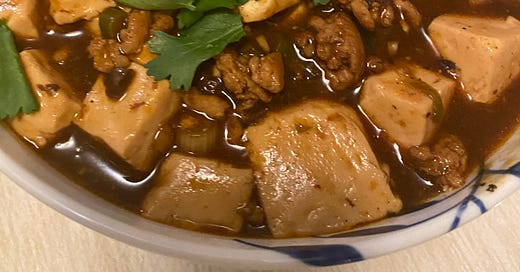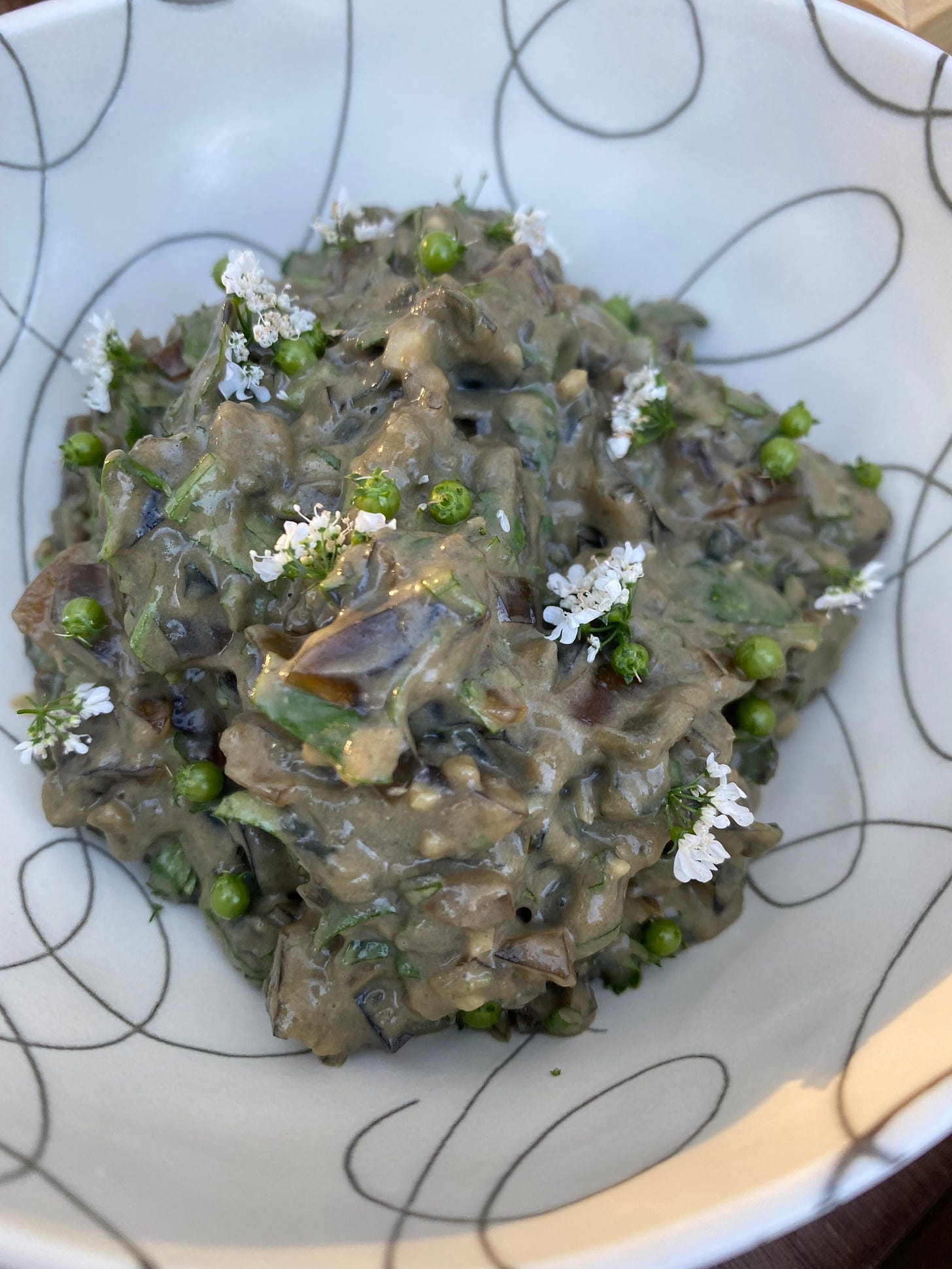Google Mapos: My New Recipe for Mapo Tofu
A Guest Chef from China Offers Some Advice, Cooking with Friends, Notes on Ingredients
Issue #14 takes us back to China, to Chengdu in Sichuan Province. Well, it’s really just to my kitchen and one of my all-time favorite dishes, mapo tofu, which hails from Chengdu. Like most things, if you have the ingredients, it’s quite quick and easy to prepare. I was lucky to have the advice of a chef friend from China to improve my mapo, and now yours, as you will read. My kitchen has become a sort of private guest-chef pop-up during the pandemic, and I realized that I should be sharing any culinary insights from these evenings cooking with friends with you, dear reader. More to come.
When I want to cook a Chinese dish for the first—or even the fifth—time, I usually consult several sources. If it’s something Sichuan, as it often is, I start with any of the books by Fuchsia Dunlop, whose recipes never disappoint. If I want to triangulate recipes and techniques, I look through the other books on my shelf—by Florence Lin, Ken Hom, or Eileen Yin Fei Lo. And then I google my favorite online sources, such as Serious Eats, Woks of Life, The Mala Market, and Woon Heng. Although strictly vegan, Woon Heng’s pan-Asian recipes seem at once authentic and doable. She has a knack, I think, for making techniques that have always seemed intimidating to me—such as making your own cheung fun, dumpling wrappers, bing, or steamed radish cakes—seem approachable. (Don’t tell her that I sometimes add back the animal products.)
Once my consultation process is complete, I usually pick one recipe I’m going to follow, sort of, informed by the others I’ve read. As I cook I try to take notes and/or remember what I did. But as with most of my home cooking, I vary what I’m doing with what I have on hand. And then sometimes I can’t remember what I did last time, what I meant to do, or where I saw something. To me, this variability is part of the fun, the thrill of cooking.

Mapo tofu is a dish I have made uncountable times after consulting nearly as many recipes. It is rarely the same twice, but it is always yummy. I’ve been pretty happy with most of my mapo tofus (or maybe it’s “mapos tofu”?). Until the just the other day.
That’s when a friend, a young chef from China, who has been stranded stateside for almost two years now due to the pandemic, made a mapo tofu in my own kitchen, with my own ingredients, that was one of the most delicious I have ever had.
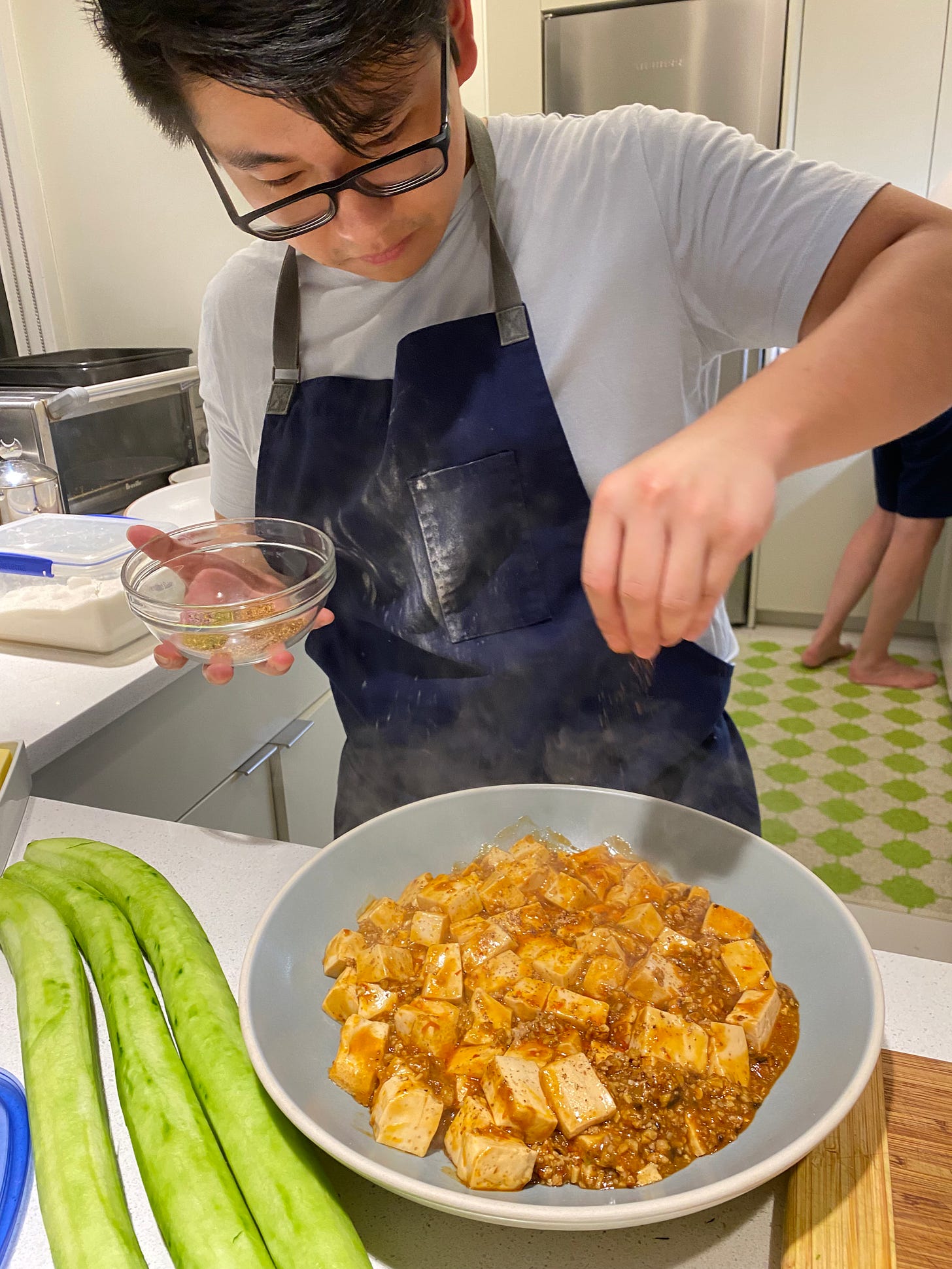
Xiaoda Lin is a young chef from Fujian who has been studying at the Culinary Institute of America and staging in various kitchens, such as Blue Hill at Stone Barns. He’s also been eating his way through New York City. He was introduced to me by our mutual friend from Shanghai, Crystyl Mo, who has also been stuck in the US since Chinese New Year 2020. Xiaoda and Crystyl have been making the gastronomic most of their time here. My husband Nate and I have enjoyed several dining experiences together with them. But each time we meet to eat out, Xiaoda says he’d like to cook for us at home.
On a recent Monday night, we were honored to have Xiaoda prepare a few dishes with Crystyl’s assistance. The first was an egg salad—mayonnaise, aromatics, such as cilantro, garlic and ginger, black rice vinegar, seasoned with oyster sauce and soy—made completely unique by his use of century eggs instead of hard-boiled. Century or 100-year-old eggs are “aged” in ash, which darkens their flesh, creating a gelatinous texture and funky, sulfurous flavor. Crystyl likens their complexity to a fine blue cheese. I’ve never really liked them before, but I found this salad yummy, especially on the selection of toasted sourdough breads Crystyl brought that her mom had made. (Crystyl produces a Youtube cooking show starring her mother called Mother Zen Chef.)
For dinner, Xiaoda also made a salad of julienned celtuce, a braise of sponge gourd, and shrimp and grits that was intended to marry with his mapo tofu. But it was the mapo tofu that stood out to me, perhaps because of the many personal references I have for its preparation. His mapo tofu was deeply flavorful, but still delicate—I might call it “elegant”—with a pleasing, almost custard like texture, and that lingering, aromatic, numbing of roasted Sichuan peppercorn. It made all the mapo tofus I’d made in the past seem clunky, rustic by comparison.
I took notes and Xiaoda’s advice and set out to change my mapo approach. He said it was important to simmer the tofu in salted water before cooking it—something I had stumbled on prior and knew to do. He was also insistent you had to let the tofu braise for some time in the spicy liquid to absorb the flavor, which many people cut short. For that liquid, he used a fresh shrimp stock, to marry better with the shrimp and grits we were eating with it. The choice of doubanjiang, or fermented spicy bean paste, was a matter of some concern. We tasted three doubanjiangs we hand on hand and he ended up using two of them to provide the complex flavor he was looking for. Xiaoda also advised not to thicken the sauce all at once, but to thicken it just a little, two or three times to get the consistency just right throughout.
What follows is a new mapo tofu recipe I developed taking Xiaoda’s advice to heart. Of course, I still can’t leave well enough alone because my mind is aswirl with mapo tofu eating experiences and recipes. I had a mapo tofu that was studded with pickles, and so I always add something pickled to mine. You can adjust the chili heat according to your taste. (Xiaoda confessed after dinner that he had toned down the spice for us.) But this recipe is a very good starting point. You won’t be disappointed. As usual for most of the recipes in this newsletter, following the recipe are some thoughts on key ingredients, what’s best to use, where to find it, and what you might have on hand that can be used instead.
RECIPE: My New Mapo Tofu
Serves 4 to 6, depending on what else is served.
1 pound silken or soft tofu
Salt
1 tablespoon red Sichuan peppercorns
1 tablespoon peanut, canola, or other high-smoke-point oil
3 ounces ground pork or beef
1 clove garlic, minced (about 1 teaspoon)
1 small knob ginger, peeled and minced (about 1 tablespoon)
1 small red chili pepper, minced (optional)
3 scallions, white and green parts separated, each finely sliced
3 tablespoons doubanjiang (Sichuan spicy fermented bean paste)
1 to 3 tablespoons fermented or pickled vegetable, finely chopped (optional)
Chili powder or chili paste, to taste
1 ¼ cups shrimp, chicken, pork, vegetable, or any stock, or water
1 tablespoon cornstarch
Toasted sesame oil (optional)
Chili oil (optional)
Freshly ground white pepper
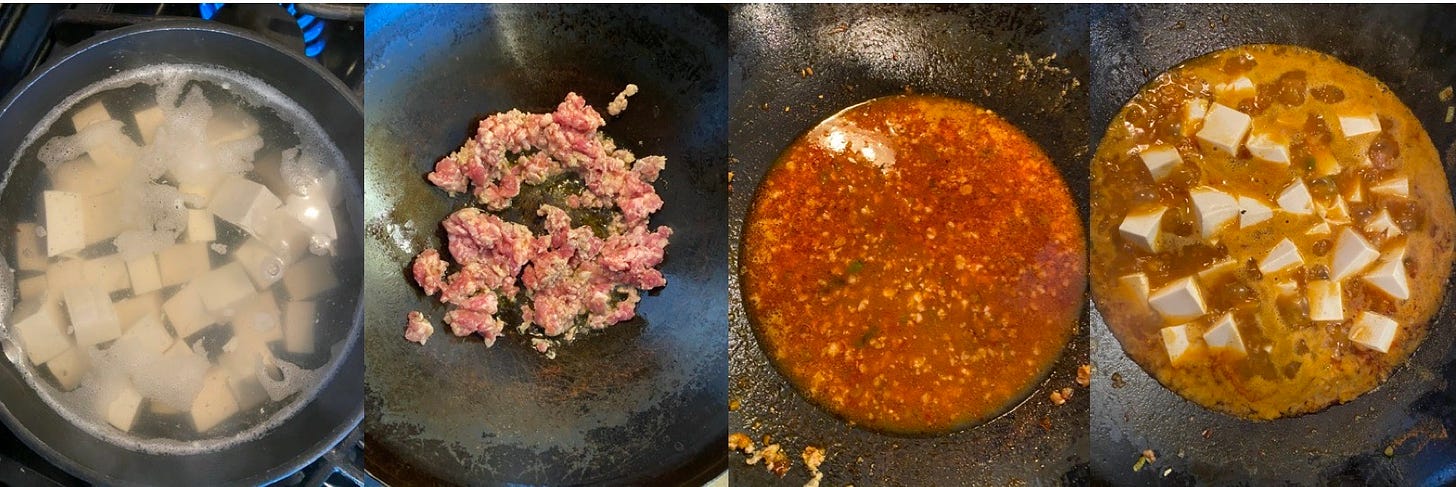
Drain and rinse the tofu and drain again. It’s fragile so handle it delicately. Slice into 1-inch cubes. Bring a small pot of water with a generous pinch of salt to a simmer. Carefully transfer the tofu cubes (a spatula works well) to the simmering water and keep at a gentle simmer while you continue. The tofu should simmer for at least 5 minutes and up to 15. This helps stabilize it.
In a small, dry sauteé pan, toast the Sichuan peppercorn over medium high heat. Keep swirling the pan to prevent burning. When the pepper is fragrant and somewhat darker looking, turn off the heat and transfer to a spice grinder or mortar and pestle, and ground to a find powder.
In the bottom of a wok or large sauté pan, heat the oil. Add the pork and cook, breaking up the meat, until it has crumbled and cooked through. Add the garlic, ginger, and hot pepper, if using, and sauté for a minute or two until fragrant. Add the white of the scallions and about half of the ground Sichuan peppercorn and cook for 30 seconds. Add the doubanjiang and cook, coating all of the pork with the paste, until the doubanjiang turns the fat in the pan red. Add additional chili powder or paste, to taste, depending on your tolerance for heat. Add the stock and bring to a simmer. It should be a nice red color. Using a fine spider or slotted spoon, carefully lift the tofu cubes from the simmering water and add to the pan with the pork mixture. When all of the tofu is in, reduce the heat to a gentle simmer and let cook for 10 minutes or so to infuse the tofu with flavor.
While the tofu is simmering, mix the cornstarch with a couple of tablespoons of water to form a slurry. Add a teaspoon or two of the slurry to the tofu and stir gently to thicken. Let cook for a few minutes. Add another teaspoon or two of slurry and repeat. Repeat one more time until the liquid has thickened but is not gloppy. Drizzle in a small amount of sesame oil and chili oil, if using, along with a grind or two of white pepper, and stir carefully to blend.
Transfer to a serving platter. Sprinkle with the rest of the toasted, ground Sichuan peppercorn and a sprinkling of scallion greens. Serve with plenty of rice.
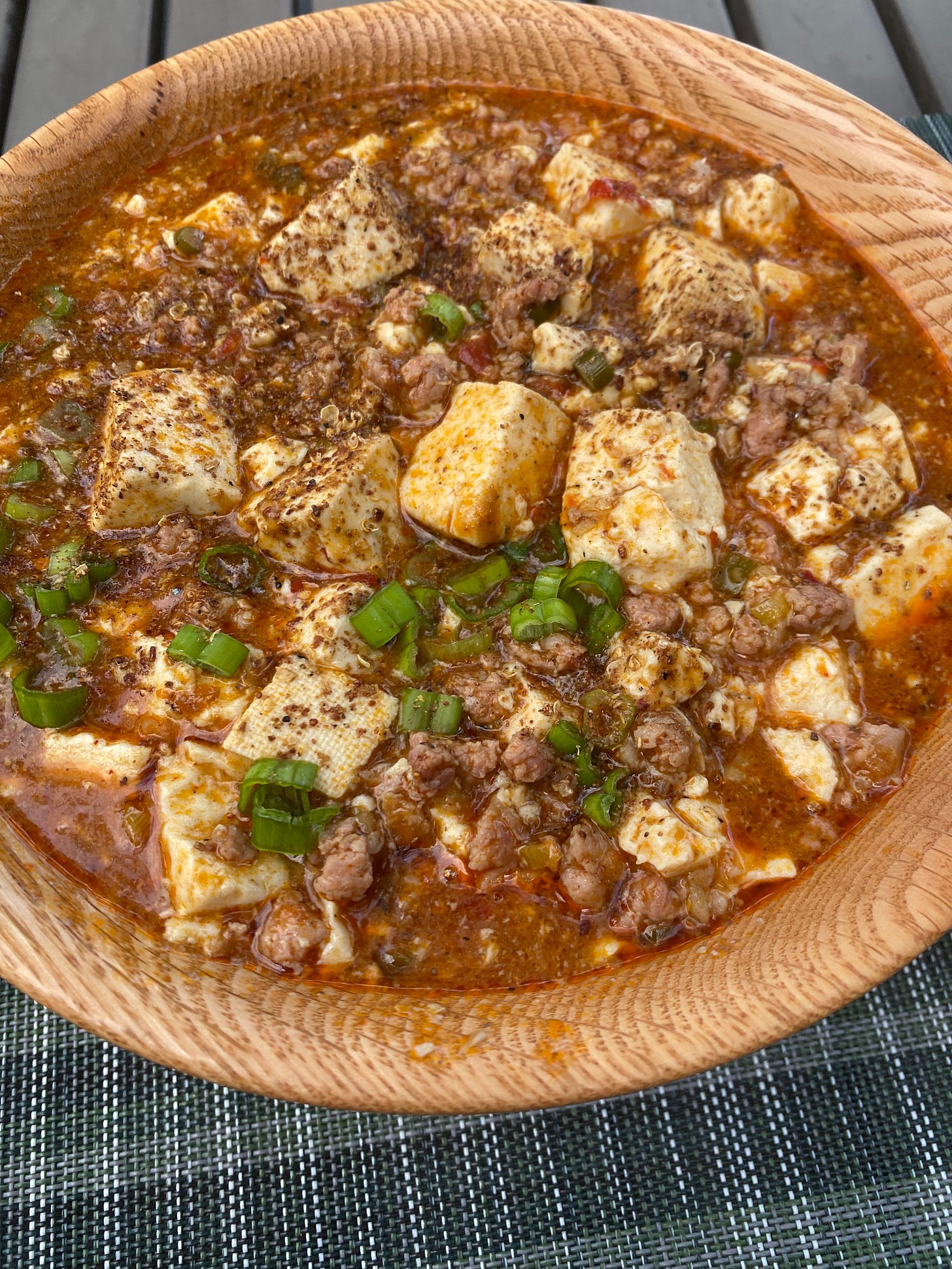
Notes on Ingredients
Tofu
It’s tempting to want to use a firm or extra-firm tofu for mapo tofu so that it holds up better to stirring and serving without disintegrating. But by doing so you lose the soft, custard-like texture that is desirable, a combination of the texture of the tofu and the cornstarch-thickened sauce. Silken tofu is different from soft tofu in the way it is made, specifically the formation of curds. It must be handled very delicately to maintain its integrity. Blanching it helps stabilize it. Of course, if you can’t find silken or soft tofu, or if you have another type of tofu on hand, using any tofu is fine. Note that “tofu” is actually the Japanese transliteration, making “mapo tofu” linguistically nonsensical. “Doufu” is generally accepted as the Chinese transliteration, but it is less common.
Sichuan Peppercorns
I knew that there were red and green Sichuan peppercorns, both of which I brought back from China. (Not that I can really tell the difference by looking at them; I’m red-green colorblind.) The red are used more commonly, while the green are called for in some fish and chicken dishes. But I didn’t realize there were stark differences in the quality of the Sichuan peppercorns you can find until I ran out of those I had imported myself and bought some cheap ones in Chinatown. Sichuan peppercorns aren’t peppercorns at all, rather they are the buds of a shrub known in English as prickly ash. The best have a fragrant, citrusy flavor and a unique numbing quality on the tongue. The worst have a dull flavor and are full of little black seeds and twigs that have to be painstakingly removed before using. I wasn’t aware of this and I couldn’t figure out why my Sichuan food took on an odd crunch until I looked more closely at it and saw many little black seeds I traced back to my cheap Sichuan peppercorns. Anyway, the lesson is, as with many spices, you get what you pay for. Read more about and find top quality Sichuan peppercorns here.
Toasting Sichuan peppercorns brings out their flavor. Use a dry pan but be careful not to burn them. They go from toasted to charred quickly. Remove them from the pan as soon as you smell a distinct, toasted flavor.
Oil
Xiaoda used peanut oil for his mapo tofu. When I have it, I use caizi you, a roasted rapeseed oil typical to Sichuan that gives a particular flavor to the food there. I have found it in Chinatown grocery stores and online. It is anything but “neutral,” but it is also not necessary. In fact, part of my perception of the lightness of Xiaoda’s mapo tofu could likely been the result of using a lighter oil. I’d gotten used to the heaviness imparted in part by the caizi you.
Meat
It seems the jury is still out on whether beef or pork is more traditional in mapo tofu, with the balance tilting toward beef. At least that is true at Chen’s Mapo Doufu, the now-state-run mapo tofu restaurant chain in Chengdu, whose original family owners are credited with creating and popularizing the dish. You can also make it with other meat, ground chicken or turkey, perhaps, or else it can be totally vegetarian. For a vegetarian version with a little more umami I sub in some ya cai, the Sichuan preserved vegetable made from the stems of a mustard plant, in place of the meat. Any of the plant-based meat substitutes would work well, too.
Doubanjiang
The secret weapon in mapo tofu (and many other Sichuan dishes) is doubanjiang, a spicy, fermented, umami-rich broad bean paste that’s deeply flavorful. Note, transliterations can be wildly different: toban djan, douban, doubanjan, among them. It is sometimes translated as “spicy broad bean paste,” “broad bean paste in red oil,” or “spicy bean paste.” Think of doubanjiang as the offspring of dark miso and gochuchang. Depending on the brand it can be saltier, funkier, or spicier. I brought back from China some of the pervasive Pixian doubanjiang that is made by the state in Pixian. It comes in jars or wrapped in paper and has salty, funky flavor and a chunky texture that is best chopped fine or puréed before being used. Crystyl likes the more subtle flavor of Lee Kum Kee’s, which Xiaoda described as more Cantonese in style. Xiaoda used some of both in his mapo tofu and we all agreed the combination provided an excellent balance.
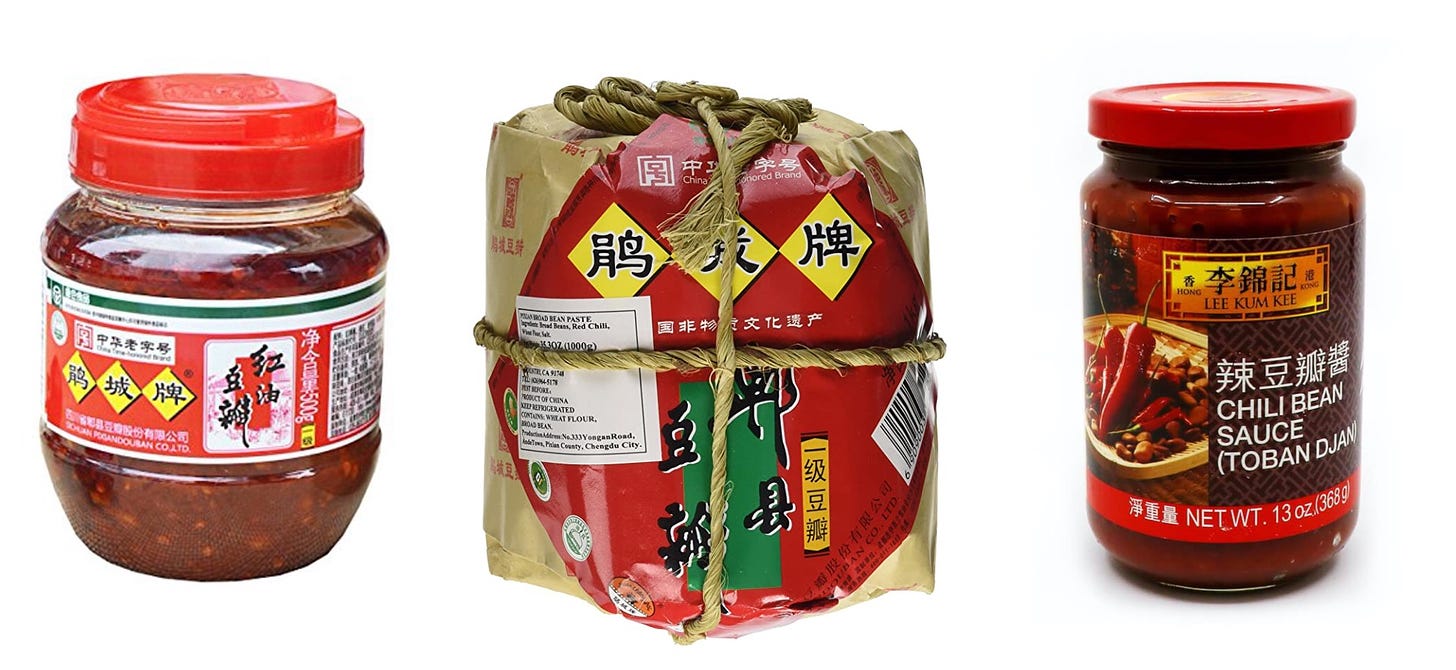
Regrets about Mapo in Chengdu
The most famous restaurant for mapo tofu in Chengdu is Chen’s Mapo Tofu, where the dish is said to have originated in the 19th century. The original, family-owned location is gone and the restaurant is now a chain owned by the state. Most of the people I consulted said it wasn’t really worth a visit. We we didn’t go to Chen’s when we were in Chengdu, and in fact, we only had mapo tofu a couple times on that trip. During the dinner at our place, Crystyl said we had made a mistake and fallen prey to foodie snobbism by avoiding Chen’s, which was still good. Ugh. #FOMO. I will just have to go back, which I would happily do. For more on the allure of mapo tofu and Chen’s, I enjoyed this Substack post by The Cleaver and the Butterfly.
